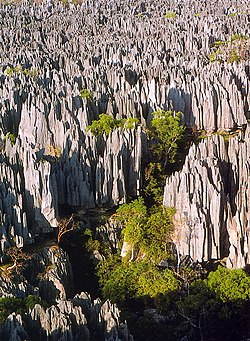Lapiaz
A lapiaz, lenar or limestone pavement is an irregular stony area or surface of carbonate or evaporitic rocks modeled by water, with multiple grooves, holes and sharp edges. The surface of each groove or cavity is usually small or medium in size, separated by partitions or rock walls in some sharp cases. Its dimensions are decimetric, although depth can sometimes exceed ten meters. Actually the lapiaz varies between a few millimeters, microlapiaz, to several meters. The lapiaces appear in outcrops of limestone or gypsum affected by karstic processes and are, therefore, elementary karstic forms.
Its genesis is produced by the superficial dissolution of the limestone affected by runoff water or stored superficially in points where the microtopography allows a better retention or channeling of water or humidity. The superficial dissolution of limestone is accelerated during the rains due to the acidity caused by carbon dioxide in the air, which becomes carbonic acid by hydration, and the action of humic acids. Limestone is a calcium carbonate that is not soluble in water, but it reacts with carbonic acid becoming calcium bicarbonate, which is soluble in water, so the calcareous soil will deepen in places where small currents are concentrated. of water.
When they are on a slope, the edges of the pencils can present some continuity. In this case, we speak of linear pencils, which can take sinuous forms that resemble river courses, and there is even talk of pencil meanders. When the fissures form a quadrangular pattern, normally a system of joints that facilitates the penetration of the solution into the rock, they define a lapiaz table, formed by a pattern of slabs delimited by the fractures. If the cavities are more or less circular they are called alveolar lapiaces.
In the dolomitic rocks, the lapiaz presents walls, natural bridges, pitons and corridors distributed in a disorderly manner throughout the region. We then speak of a ruiniform karstic relief.
These karstic forms can appear in association occupying a large and rugged surface. In some cases they can reach important metric dimensions and be very separated from each other, constituting macrolapiaces that define landscapes popularly known as "enchanted cities", as is the case of Mar de Piedra, in the Enchanted City of Cuenca.
Contenido relacionado
Zhytomyr Oblast
Lithification
Krigage


